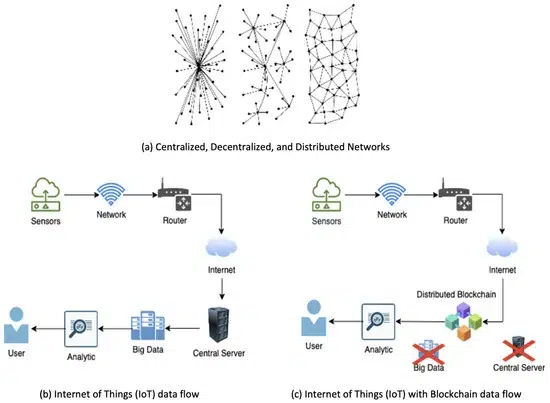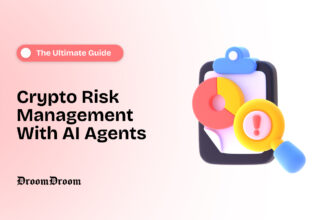IoT is not just a buzzword—it’s the backbone of modern innovation, driving efficiencies in healthcare, manufacturing, smart cities, and beyond. Yet, as IoT networks grow in scale, the traditional centralized models that support them are straining under pressure.
- What is IoT and Why is it Relevant in Today’s Age?
- Why is There a Need to Rethink the Current Centralized Infrastructure?
- The Role of Hybrid DLT in Modern Connectivity: Decentralization as the Future of IoT
- Why We Should Be Concerned About Quantum Security
- The Need for Quantum-Secure Decentralized Infrastructure in IoT
- Why This Transition is Non-Negotiable
- Quranium’s Approach to Quantum-Resistant Modern Connectivity
- Benefits of Quranium’s Architecture for IoT Applications
- The Future of Humanity and Machines Co-Existing
Centralized architectures, where data is funneled to and processed by a central server, are less than ideal for handling the complexities of modern IoT ecosystems. Not to mention, this architecture presents significant challenges, including security vulnerabilities, scalability limitations, and privacy concerns.
As we stand on the brink of the quantum computing era, the vulnerabilities inherent in current systems are poised to become even more pronounced.
To address these challenges, the shift towards decentralized IoT networks is gaining momentum—especially with Quantum-Proof Hybrid Distributed Ledger Technology (DLT) infrastructure leading the way.
The role of hybrid DLT in modern connectivity is crucial as it transforms IoT systems by enhancing security, scalability, and decentralization. By decentralizing data management, a hybrid DLT enables more resilient and efficient networks, ensuring seamless communication between interconnected devices.
In this article, we will showcase how the world’s first Quantum-Proof Hybrid DLT, Quranium, is paving the way for enhanced connectivity between humans and machines across various sectors, with a potential to adapt to quantum threats and continue to offer decentralization, powerful security, and scalability.
What is IoT and Why is it Relevant in Today’s Age?
The relevance of IoT today is undeniable; it’s the technology that powers smart grids, tracks logistics in real-time, and even monitors patient health remotely.
But, what is it exactly?
The Internet of Things (IoT) represents the network of physical objects—devices, vehicles, buildings—embedded with sensors, software, and connectivity that enable them to collect and exchange data. IoT networks consist of billions of interconnected devices, from sensors in smart homes to industrial robots, all sharing data and enabling real-time decision-making.
For instance, wearable devices monitor patients’ vital signs and provide real-time data to healthcare providers, enhancing patient outcomes and reducing hospital visits. In smart cities, IoT optimizes energy consumption, manages traffic, and enhances public safety, contributing to more sustainable and livable environments.
Why is There a Need to Rethink the Current Centralized Infrastructure?
As per a research paper on “Enhancing Healthcare Efficacy Through IoT-Edge Fusion,” traditional cloud computing systems are struggling to meet the demands of healthcare.
Centralized infrastructure in IoT involves data collection from devices being transmitted to a central server or cloud for processing. While familiar, there are three main issues—
- Security Vulnerabilities
Centralized systems present a single point of failure, making them prime targets for cyberattacks. The 2016 Mirai botnet attack, which leveraged IoT devices to launch one of the largest DDoS attacks, is a stark reminder of the vulnerabilities in centralized IoT networks.
The role of hybrid DLT in modern connectivity is to mitigate these risks by distributing data across a decentralized network, making it harder for attackers to compromise the system.
- Scalability Issues
As the number of IoT devices grows exponentially, centralized systems struggle to scale effectively. The sheer volume of data generated by billions of connected devices can overwhelm central servers, leading to latency, bottlenecks, and inefficiencies. This is particularly problematic in applications that require real-time data processing, such as autonomous vehicles or industrial automation.
For example, Healthcare data is growing rapidly, and traditional cloud systems often can’t handle the increasing workload, especially when it comes to protecting sensitive information.
The role of hybrid DLT in modern connectivity addresses this by enabling a more scalable architecture that can handle the increasing data volumes generated by IoT networks.
- Privacy Concerns
Centralized architectures require users to surrender control of their data to third-party service providers, raising significant privacy issues. In sectors like healthcare, where data sensitivity is paramount, this lack of control can be particularly problematic. Patients may be hesitant to share their data if they are unsure how it will be used or if it will be adequately protected.
These challenges highlight the urgent need for a shift towards a decentralized infrastructure—one that not only scales with the growing network but also enhances security and privacy.
The Role of Hybrid DLT in Modern Connectivity: Decentralization as the Future of IoT
Decentralization offers a transformative solution to the challenges posed by centralized IoT infrastructures. By distributing data across a network of nodes rather than relying on a central authority, the role of hybrid DLT in modern connectivity enhances security, scalability, and privacy.

Traditionally, IoT data is funneled through a central server, which complicates direct device interactions. However, with blockchain, data is stored on a distributed ledger, enabling direct interactions between devices without relying on a central server. This shift is illustrated in the image above, which contrasts traditional IoT data flow with blockchain-enhanced IoT data flow.
Enhanced Security
In a decentralized network, data is spread across multiple nodes, eliminating the single point of failure that makes centralized systems vulnerable. This distribution makes it significantly harder for attackers to compromise the system.
For instance, blockchain-based IoT security platforms like Filament use decentralized technology to secure machine-to-machine (M2M) communications, ensuring only authorized devices interact with each other.
Improved Scalability
Decentralized systems can handle more devices and larger data volumes without performance degradation, as the workload is distributed across multiple nodes. The role of hybrid DLT in modern connectivity is crucial for IoT applications in smart cities, where real-time data processing is necessary to manage traffic, utilities, and other critical services.
Strengthened Privacy
Decentralization empowers users with greater control over their data. In a decentralized IoT network, data can be encrypted and stored across multiple nodes, ensuring that only authorized parties have access.
This approach aligns with privacy-by-design principles and helps build trust among users. For example, the IoT platform IOTA uses a decentralized ledger to enable secure data sharing between devices, ensuring that data remains private and tamper-proof.
Why We Should Be Concerned About Quantum Security
Quantum computing, once a distant theoretical concept, is now on the cusp of becoming a reality. Unlike classical computers, which process information using bits, quantum computers use qubits, allowing them to perform complex calculations at unprecedented speeds.
While this holds immense potential for various industries, it also poses a significant threat to traditional cryptographic systems. Encryption methods like RSA and ECC, which currently secure everything from online banking to IoT networks, could be rendered obsolete by the computational power of quantum computers.
For IoT networks, the implications are dire. These networks rely heavily on existing cryptographic methods to secure the vast amounts of data they generate. If quantum computers can break these encryption methods, IoT devices and the data they handle could be exposed to unauthorized access, manipulation, and theft.
This vulnerability is particularly concerning for critical sectors such as healthcare, finance, and national security, where the integrity and confidentiality of data are paramount.
Integrating hybrid DLT with IoT networks allows for unprecedented levels of security and efficiency. At Quranium, we ensure that data across IoT devices is managed in a transparent, tamper-proof manner, reducing the risk of security breaches while enhancing the functionality of connected devices.
Yaduvendra Yadav, Co-founder & CTO, Quranium
The role of hybrid DLT in modern connectivity is crucial here, as integrating hybrid DLT with IoT networks allows for unprecedented levels of security and efficiency. This approach ensures that data across IoT devices is managed in a transparent, tamper-proof manner, reducing the risk of security breaches while enhancing the functionality of connected devices.
The Need for Quantum-Secure Decentralized Infrastructure in IoT
The urgency of developing quantum-secure decentralized infrastructures for IoT cannot be overstated. The U.S. National Institute of Standards and Technology (NIST) recently underlined this need by standardizing three post-quantum cryptography (PQC) encryption schemes, with a fourth on the way.
These standards represent a significant milestone in the journey towards quantum resilience, providing the tools needed to secure IoT networks against future quantum threats.
NIST’s initiative is a clarion call for industries relying on IoT to transition to quantum-safe cryptography. The concept of “harvest now, decrypt later” illustrates the immediacy of the threat—data encrypted today could be vulnerable to quantum decryption in the future.
As such, integrating quantum-resistant cryptographic algorithms into IoT infrastructures is not just a precaution—it’s a necessary evolution in cybersecurity.
Why This Transition is Non-Negotiable
Adopting a quantum-secure decentralized infrastructure is not a matter of if, but when. As IoT continues to expand and quantum computing becomes more accessible, the risks associated with outdated cryptographic methods will only intensify. Organizations that fail to adapt are likely to face heightened security risks, regulatory scrutiny, and a potential loss of trust from consumers and stakeholders.
In critical sectors such as healthcare, finance, and infrastructure, where the security of IoT networks is paramount, the transition to quantum-secure infrastructures is non-negotiable.
The costs of inaction are too high, including the risk of catastrophic breaches, financial losses, and irreversible damage to reputation. This is not just about staying ahead of technological advancements; it’s about ensuring the long-term integrity and trustworthiness of IoT systems in a post-quantum world.
Quranium’s Approach to Quantum-Resistant Modern Connectivity
Quranium is leading the charge in building a quantum-secure decentralized infrastructure designed specifically for the modern IoT space. By integrating hybrid DLT with state-of-the-art quantum-resistant cryptographic algorithms, Quranium provides a future-proof solution that safeguards IoT networks against both current and emerging threats.
Hybrid Dual-Layer Architecture with Dedicated IoT Infrastructure
Quranium’s infrastructure is built on a powerful dual-layer architecture, with each layer serving a distinct purpose:
Core Layer: PoW Blockchain
The core layer of Quranium is built on a Proof of Work (PoW) blockchain, renowned for its powerful security and resistance to attacks. This layer serves as the immutable backbone of the platform, securing the ledger against alterations and ensuring the integrity of the network.
Crust Layer: PoR BlockDAG
Encapsulating the core is the PoR (Proof of Respect) BlockDAG layer, optimized for handling the execution of smart contracts and other large-scale transactions. This layer enhances scalability and transaction speed, ensuring efficient processing. The PoR consensus mechanism within this layer promotes a more democratic and equitable network by rewarding validators and participants based on their contributions.
Dedicated IoT Infrastructure
Separate from the general Crust Layer, Quranium includes a specialized infrastructure optimized specifically for IoT applications. This IoT-dedicated later of the infrastructure handles the vast amounts of data generated by IoT devices, focusing on microtransactions and real-time data exchanges.
By isolating IoT transactions in this dedicated infrastructure, Quranium ensures that these transactions are processed with minimal latency, free from congestion that could arise from other network activities.
SPHINCS+: A Post-Quantum Algorithm
Quranium incorporates quantum-resistant algorithms, such as SPHINCS+ and adding a padding of WOTS+, to safeguard against potential quantum attacks.
SPHINCS+ is a NIST-approved hash-based cryptographic algorithm that offers strong security guarantees under various attack models, including those involving quantum computers. Its stateless nature simplifies key management within blockchain technologies, making it a critical component of Quranium’s quantum-proof infrastructure.
This not only prepares the Quranium platform for future advancements in quantum computing but also enhances its appeal as a secure platform for industries that prioritize data integrity and security.
With the quantum era on the horizon, Quranium is proactively integrating quantum-resistant algorithms like SPHINCS+ to safeguard against potential security threats. This ensures that our blockchain remains secure against future technological advances and continues to provide a trusted platform for digital transactions.
Kapil Dhiman, Co-founder & CEO, Quranium
The role of Quranium in this dual aspect—enhancing connectivity and securing against quantum threats—highlights the broader potential of hybrid DLTs to adapt to and anticipate technological advancements and challenges.
Benefits of Quranium’s Architecture for IoT Applications
Here’s an exploration of how Quranium’s hybrid DLT architecture benefits IoT applications with the help of real-world sectors:
- Supply Chain Management
Quranium can be employed to create a transparent and efficient supply chain where all transactions and product movements are recorded on a secure, immutable ledger. IoT devices integrated with Quranium’s DLT can track goods from production to delivery in real-time, reducing fraud and ensuring the authenticity of products.
- Smart Homes and Cities
The integration of IoT with DLT has significantly impacted smart homes and cities, creating a more decentralized, secure, and interconnected digital ecosystem.
In smart homes, IoT devices can autonomously manage energy usage, security, and maintenance tasks, with all data transactions securely logged on Quranium’s blockchain.
Similarly, in smart cities, IoT devices can help manage traffic flow, public safety, and utility services effectively, with enhanced data security and operational efficiency.
- Healthcare
Wearable IoT devices that monitor patient health metrics can securely transmit data to blockchain-based medical records managed by Quranium’s architecture. This ensures that patient data is kept private and secure, accessible only to authorized personnel, and facilitates real-time, personalized healthcare services.
The Future of Humanity and Machines Co-Existing
The integration of hybrid DLTs into IoT systems offers a compelling solution to the longstanding challenges of security, scalability, and centralization.
With that, the need for secure and scalable infrastructures like Quranium’s hybrid DLT becomes increasingly non-negotiable.
With the backing of NIST’s newly standardized post-quantum cryptographic algorithms, Quranium is well-equipped to provide the foundational security required for a world where humans and machines coexist in a highly interconnected and data-driven environment.
In this vision, IoT devices are not only secure against today’s cyber threats but are also resilient to the challenges posed by quantum computing.
Quranium’s overall architecture strategically addresses scalability—a common limitation in traditional blockchain systems—by allowing more transactions to be processed in parallel.
Scalability is essential for modern connectivity, especially in IoT-dense environments requiring real-time data processing. This ensures the DLT can handle large data volumes without bottlenecks, making possible smooth communication between diverse and geographically distributed devices.
Quranium’s integration with edge computing brings data processing closer to its source. This significantly reduces delay and improves performance for real-time applications like autonomous driving, smart grids, and remote healthcare.



















